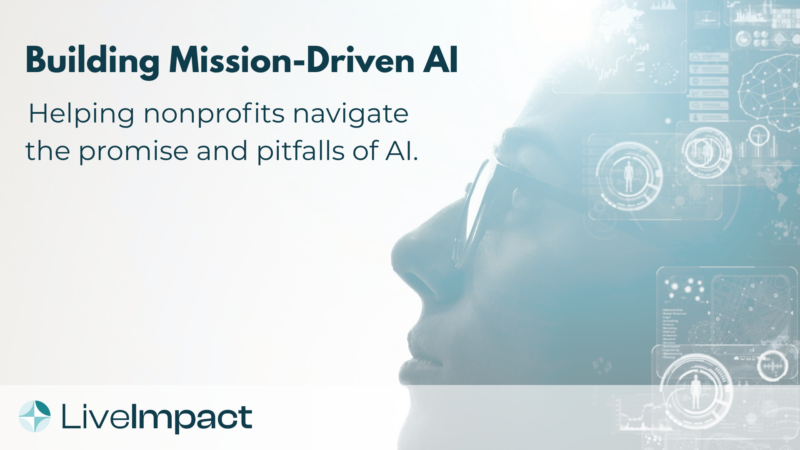This article is part of a series we’re publishing to help nonprofits gain clarity on artificial intelligence—cutting through the hype to focus on what really matters.
There’s no question that AI can help nonprofits do more, faster—with less. But to realize that promise, you need more than curiosity. You need strategy, safeguards, and a clear understanding of how this technology fits your mission.
In this series, we’ll continue breaking down what AI really means for nonprofits. From automation to accessibility, from case management to website performance, we’ll explore both the risks and the opportunities—and how to chart a course that’s smart, ethical, and sustainable.
The Opportunity—and the Noise
AI is no longer on the horizon. It’s here.
From donor engagement to service delivery, AI is already beginning to influence how nonprofits operate. But while the buzz around generative tools like ChatGPT and DALL·E is widespread, what’s often missing is a grounded, strategic conversation—especially one that centers the specific needs and values of the nonprofit sector.
Having built technology solutions for nonprofits for over a decade, I’ve seen this cycle repeat itself. A new technology shows up full of promise, and in the rush to adopt it, organizations often end up reshaping their mission to fit someone else’s toolset. With AI, that’s a risk we can’t afford.
But alongside the risks lies a real opportunity. AI, when thoughtfully implemented, can dramatically improve internal efficiency, expand accessibility for program participants, and uncover growth opportunities that were previously hidden in data. It can help overburdened teams automate intake, reduce manual data entry, deliver multilingual services, and surface quick, actionable insights that support smarter decisions.
The promise of AI for nonprofits is real—but so is the need to engage with it critically. To make it work, nonprofits need more than access to tools. They need clarity, control, and a roadmap rooted in their mission—not someone else’s business model.
Step 1: Understand What AI Is (and What It Isn’t)
Not all AI is the same. What’s powering your AI experience—how it’s trained, what it’s trained on, and how it operates behind the scenes—matters enormously. There’s a big difference between:
- Generative AI (GenAI): Tools that create new content—text, images, code—based on large, general-purpose datasets
- Operational AI: AI integrated into systems to automate, optimize, or personalize internal workflows and external experiences
Most nonprofits start exploring GenAI to draft emails, write reports, or create visuals. That’s a useful beginning, but it’s just the surface.
The deeper value lies in Operational AI—where it supports decision-making, improves data quality, automates workflows, and enables entirely new capabilities tailored to your organization’s context.
Step 2: Be Clear About the Data
AI is only as trustworthy as the data behind it. In the nonprofit world, that’s a complex topic. Here’s why:
- Many AI vendors train models using aggregated data from multiple organizations
- While they may claim to exclude personally identifiable information (PII), nonprofits often haven’t secured consent to share data—even anonymized
- Combining datasets across nonprofits introduces risks: privacy, compliance, and model relevance
Your nonprofit’s data is mission-specific. The communities you serve, the outcomes you measure, the language you use—all of it is unique. Feeding that into a generalized model dilutes your voice and opens the door to unintended consequences.
A smarter approach: choose AI solutions where your data is kept private, is not pooled or sold, and where models are trained specifically on your context. Anything less, and you’re outsourcing both insight and integrity.
Step 3: Start with Real-World Problems, Not Features
The right way to adopt AI isn’t to chase capabilities—it’s to start with challenges. Ask:
- What’s taking up too much of our staff’s time?
- Where are we losing opportunities to engage donors or participants?
- What data do we have, and what decisions could it support?
Then explore how AI might help—whether it’s automating thank-you emails, predicting donor churn, flagging incomplete intake records, or guiding someone through your website in their preferred language.
Let your mission drive the technology, not the other way around.
Step 4: Think Accessibility, Equity, and Capacity
Nonprofits have a duty to ensure AI doesn’t just serve those with the loudest voices or easiest access. As you explore use cases, consider how AI might help:
- Translate content for multilingual audiences
- Generate screen-reader-friendly materials
- Personalize support for underserved or complex cases
- Reduce support staff load by answering common questions through AI widgets
These aren’t futuristic ideas—they’re real use cases already delivering impact for nonprofits today.
Step 5: Build a Roadmap, Not a Reaction
AI is not a single project—it’s a capability you build over time. That’s why it’s critical to:
- Involve your leadership, program, fundraising, and IT teams early
- Set clear guidelines around data usage and consent
- Pilot small, learn fast, and scale only when it works
- Regularly review your tools for accuracy, bias, and usefulness
And most importantly—consult AI experts who understand the nonprofit sector. It’s not just about having the tech chops; it’s about knowing how to apply AI ethically and effectively within a mission-driven environment.
Our goal is to equip mission-driven organizations with the insight they need to confidently evaluate the opportunities, risks, and practical paths for leveraging AI in support of their work.
AI is a tool. You are the strategy. Let’s build that strategy together.


